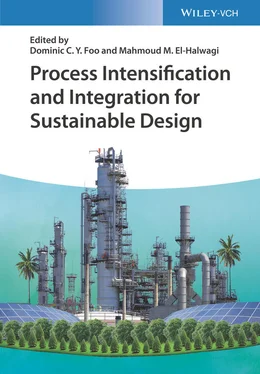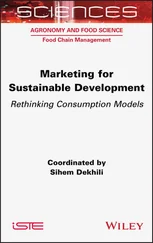1 Chapter 1 Figure 1.1 Safety, sustainability, and economic indicator for different pres... Figure 1.2 Simultaneous phenomena building blocks in a conventional distilla... Figure 1.3 Basic flowsheet for ethylene production from shale/natural gas.
2 Chapter 2 Figure 2.1 Shale gas treatment process. Figure 2.2 Overview of the methodology. Figure 2.3 Glycol dehydration process. Figure 2.4 Turboexpander process (stream 19 shows the recovery of recompress... Figure 2.5 Fractionation train. Figure 2.6 Acid gas removal unit. Figure 2.7 Comparison of gas composition with revenue. Figure 2.8 Economic metrics for the additional cases. Figure 2.9 Phase envelope for Feed #1 before the demethanizer column (genera... Figure 2.10 IROI based on feed probability. Figure 2.11 Revenue for the high acid gas case and base case (MM$/yr). Figure 2.12 Measured contributions to variance on ROI for the inputs. Figure 2.13 Results for Cases 1–3 for the sensitivity analysis. Figure 2.14 Price of products over time [34]. Figure 2.15 Results for Cases 4–6 for the sensitivity analysis.
3 Chapter 3 Figure 3.1 Energy use of (a) a single‐stage RO and (b) two‐stage RO desalina... Figure 3.2 Schematic diagram of a closed‐circuit reverse osmosis process....Figure 3.3 Schematic representations of (a) FO, (b) PRO, (c) RO processes, a...Figure 3.4 Schematics of the ICP, concentrative ECP, and dilutive ECP. Herei...Figure 3.5 Schematic of a single‐stage RO unit with ERD.Figure 3.6 Schematic diagram of RO pressure vessel [14].Figure 3.7 Schematic representation of a PRO unit (FS, feed solution; DS, dr...Figure 3.8 Schematic diagrams of the RO–PRO hybrid system with (a) open‐loop...Figure 3.9 Optimal NSECs of the (a) closed‐loop and (b) open‐loop RO–PRO con...Figure 3.10 The optimal γ PROin (a) closed‐loop configuration and (b) o...Figure 3.11 Optimal Δ P RO/ π 0in (a) closed‐loop configuration and (b) op...
4 Chapter 4Figure 4.1 Schematic defining the length scales of interest associated to th...Figure 4.2 Experimental challenges that restraint the elucidation toward con...Figure 4.3 Time and distance in multiscale modeling of membrane [12].Figure 4.4 Preparation of PSF polymeric layer [35].Figure 4.5 Methodology and basis to elucidate mixed gas (a) diffusivity, (b)...Figure 4.6 Schematic representation of process flow in Aspen HYSYS to study ...Figure 4.7 Economic parameters involved in computation of IRR for process ec...Figure 4.8 Gas transport properties of ∼500 Å ultrathin PSF films under vary...Figure 4.9 Effect of thickness upon confinement toward O 2permeance (mixed g...Figure 4.10 Effect of thickness upon confinement toward N 2permeance (mixed ...Figure 4.11 Sorption sites and density distribution, shown in red and green ...Figure 4.12 Prediction of macroscopic membrane separation performance, which...Figure 4.13 Membrane area requirement to achieve product quality of 90% reco...Figure 4.14 Effect of operating conditions to the stage cut of ultrathin pol...Figure 4.15 Effect of operating conditions to the compressor power of ultrat...Figure 4.16 Effect of operating conditions to the product recovery of ultrat...Figure 4.17 Effect of operating conditions to the turbine power of ultrathin...Figure 4.18 Effect of operating conditions to the IRR of ultrathin polymeric...
5 Chapter 5Figure 5.1 Illustration of membrane electrocoagulation flocculation where (a...Figure 5.2 Effect of NaCl loading and energy input on dye removal efficiency...Figure 5.3 Effect of electrocoagulation time on dye removal (a) and flux in ...Figure 5.4 Comparison between dye removal efficiency in ECF and MECF using 1...Figure 5.5 Biomass concentration produced using perforated and membrane aera...Figure 5.6 Preliminary static force analysis on bubble formed through membra...Figure 5.7 Conceptual bubble formation under different surface wettability a...Figure 5.8 Impact of hydrophilic coating (PEBAX®) at different concentration...Figure 5.9 Forward osmosis process.Figure 5.10 Alternatives of draw solution regeneration methods of FO using (...Figure 5.11 Integrated FO membrane with an electrolysis unit.Figure 5.12 Experimental lab setup for forward osmosis–electrolysis unit....Figure 5.13 Performance of forward osmosis (FO) unit with non‐circulated (on...Figure 5.14 Performances of the FO–electrolysis unit with draw solution init...Figure 5.15 Future possible application of integrated forward osmosis–electr...
6 Chapter 6Figure 6.1 Conceptual design of HIDiC.Figure 6.2 Heat panels in the stripping section.Figure 6.3 Cross section of HIDiC with heat panels in the stripping section....Figure 6.4 Hierarchy for HIDiC design.Figure 6.5 Design procedure of HIDiC with constant heat transfer area per st...Figure 6.6 HIDiC basic design configuration (8 trays in stripping column and...Figure 6.7 Heat transfer between stages for top‐integrated column configurat...Figure 6.8 Heat transfer between stages for bottom‐integrated column configu...Figure 6.9 Geometrical analysis of concentric HIDiC configuration.Figure 6.10 Bottom‐integrated column configuration.
7 Chapter 7Figure 7.1 The vapor compression heat pump system.Figure 7.2 Pinch location is unchanged after setting a heat pump.Figure 7.3 GCC with a pinch interval below the original pinch after placing ...Figure 7.4 GCC with decreased pinch temperature after placing a heat pump: (...Figure 7.5 A heat pocket exists below the original pinch and GCC with decrea...Figure 7.6 GCC with a pinch interval above the original pinch after placing ...Figure 7.7 GCC with increased pinch temperature after placing a heat pump: (...Figure 7.8 A heat pocket exists above the original pinch and GCC with increa...Figure 7.9 Heat integration based on the increased pinch temperature: (a) ba...Figure 7.10 Heat integration based on the increased pinch temperature (a hea...Figure 7.11 Heat integration based on the decreased pinch temperature: (a) b...Figure 7.12 Heat integration based on the decreased pinch temperature (a hea...Figure 7.13 Heat integration with no change in pinch temperature.Figure 7.14 Example for identifying the operating parameters of heat pump.Figure 7.15 Determining the streams to be integrated with heat pump.Figure 7.16 Identification of heat pump placement based on GCC: (a) determin...Figure 7.17 Improvement of heat pump placement.Figure 7.18 Resulting network after implementing the heat integration.
8 Chapter 8Figure 8.1 Interactions between HEN and reactor.Figure 8.2 An HRPD with hot and cold composite curves.Figure 8.3 Variation of hot and cold composite curves when temperatures of S...Figure 8.4 Procedure for determining the new composite curves and energy con...Figure 8.5 The reactor character diagram for reactor with exothermic reactio...Figure 8.6 The energy consumption analysis diagram for consumptions evaluati...Figure 8.7 The combined multi‐parameter optimization diagram (CMOD).Figure 8.8 Variation of pinch position caused by the change of reactor tempe...Figure 8.9 The flowsheet of benzene to cyclohexene process.Figure 8.10 The CMOD for benzene to cyclohexene process.
9 Chapter 9Figure 9.1 Velocity related performances of heat exchanger.Figure 9.2 The relation between velocity and different cost elements.Figure 9.3 Fouling threshold curve.Figure 9.4 Pictorial representation of the heat exchanger fouling calculatio...Figure 9.5 Time discretization for modeling cleaning condition.Figure 9.6 Diagram of crude oil preheat train for Case Study 1.Figure 9.7 Fouling threshold curve and exchangers condition in base case (Ca...Figure 9.8 Initial velocity distribution in the base and optimized case.Figure 9.9 Initial and average heat duty of heat exchangers in base and opti...Figure 9.10 Fouling rates of E6 and E1A both in base and optimized cased.Figure 9.11 Comparison of FIT in the base and optimized cases.Figure 9.12 Diagram of crude oil preheat train for the Case Study 2.Figure 9.13 FIT profiles for selected scenarios over the whole time horizon....Figure 9.14 FIT profiles for selected scenarios over the whole time horizon:...
Читать дальше












